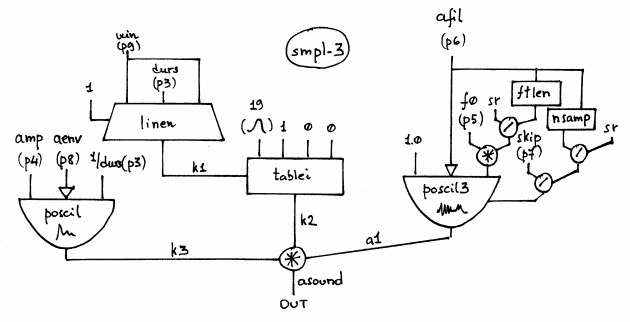Using a deferred table with SMPL-3
Tutorial SMPL-3
Name | Description | Default value |
|---|---|---|
amp | Maximum Amplitude. Linear from >0.0 to 1000 or in dB from 0 to -∞ (see Tutorial Getting Started 02 - Amplitude and Internal Editor for more details) | 0.0 |
f0 | Transpose the pitch of input sound by this factor (e.g. 0.5 means one octave lower, 2 is one octave higher, and 1 is the original pitch). Fractional and negative values are allowed (the latter results in playing the file backwards) | 1.0 |
afil | Audio file [name, with possible path, sound, string, pathname or GEN01] | 31 |
skip | (Minimum) starting point when reading an audio file [sec] | 0.0 |
aenv | Amplitude Envelope [GEN] | Instance: GEN07 |
win | Attack and decay time in [sec] | 0.01 |
The SMPL-3 Class is a Sampler with the following controls:
- The main ampllitude,
- The transposition factor,
- The starting point of the audio file,
- The amplitude envelope by means of a GEN routine,
- The attack and decay time of the total duration of the amplitude envelope.
The examples shows two ways how to pass the deferred table(s) to the class.
The example A shows the correct syntax of the directing assignment of a GEN01 function to the tables keyword "tables"
The examples B uses the GEN01 Class directing connected to the afil input slot
The meaning of the other slots is the same as the SMPL-1 Class. So see the Tutorial SMPL-1 for more details.
The SAMPL-1, SAMPL-2, SAMPL-A1 and SAMPL-A2 read every time the soundfile from the hard disk, i.e. it will be an access to the hard disk for all the i-statements (or events) even though the soundfile is always the same.The SAMPL-3 and SAMPL-4 use the GEN01 subroutine which transfers data from a soundfile into a function table, i.e. the audiophile is charged only once on the RAM.So for better computational performance is better to use the GEN01 routine if there are few soundfile.
For the red patch Synt see Appendix A
Inside the Class
instr 1
idur = p3
idurosc = 1/idur
iamp = (p4 > 0.0 ? (p4*0.001*0dbfs) : (ampdbfs (p4)))
iamp = iamp/0dbfs ; since sfile is not normalized, reduce amp between 0 and 1
ifile = p6 ; must be a GEN01, non normalized
ixpf = p5*(sr/ftlen(ifile)) ; to match the SI of the table with transposition
iskip = p7 ; in secs
ifilesize = nsamp(ifile) ; size of the sound file (samples)
ifiledur = ifilesize/sr ; duration of the sound file
iphs = iskip/ifiledur ; convert iskip to phase (0-1)
iaenv = p8 ; global amplitude envelope
ixin = (p9 > idur/2 ? idur/2 : p9) ; local envelope
ixout = ixin
ixmode = 1 ; index between 0 and 1
ixoff = 0 ; index offset
iwrap = 0 ; do not wrap around if the end of the table is reached
isigfun = 19 ; sigmoid function
; local envelope (for the grain)
k1 linen 1,ixin,idur,ixout
k2 tablei k1,isigfun,ixmode,ixoff,iwrap
; global envelope
k3 poscil iamp, idurosc, iaenv
; file reading
a1 poscil3 1.0, ixpf, ifile, iphs
asound = a1*k2*k3
outc asound
endin
- OMChroma User Manual
- System Configuration and Installation
- Getting started
- Managing GEN function and sound files
- Predefined Classes
- Additive Synthesis
- Buzz Synthesis
- Frequency Modulation Synthesis
- Formant Wave-Function Synthesis (FOF)
- Granular Formant Wave Function (FOG)
- Karplus-Strong
- Random Amplitude Modulation
- Sampler
- Reading from a sound file
- Using a deferred table
- Using a deferred table with SMPL-3
- Using a deferred table with SMPL-4
- Crossfading Looper
- Subtractive Synthesis
- Wave Shaping Synthesis
- Hybrid Models
- User-fun
- Creating a new Class
- Multichannel processing
- Appendix A - Common Red Patches


